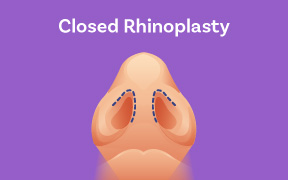
Select City
Improve your breathing issues with personalised treatment solutions at Pristyn Care. We offer safe and advanced nose plastic surgery options. Consult our experts to improve both function and appearance of your nose with lasting results.
Improve your breathing issues with personalised treatment solutions at Pristyn Care. We offer ... Read More




Free Consultation

Free Cab Facility

No-Cost EMI

Support in Insurance Claim

1-day Hospitalization

USFDA-Approved Procedure
Choose Your City
It help us to find the best doctors near you.
Bangalore
Chennai
Coimbatore
Delhi
Hyderabad
Kochi
Kozhikode
Mumbai
Pune
Vijayawada
Delhi
Hyderabad
Pune
Mumbai
Bangalore

When the nasal structure lacks proportion or symmetry, it affects the overall attractiveness of the face. Rhinoplasty corrects size, angle and contours to achieve a more balanced and natural look. It also corrects and resolves internal structural problems that cause breathing difficulties. Through proper surgical techniques, rhinoplasty helps to achieve both functional and aesthetic results.
Rhinoplasty is recommended for people looking for a permanent aesthetic uplift. With advanced techniques, the outcomes are more precise than ever.
• Disease name
Nose Reshaping Requirement
• Surgery name
Rhinoplasty
• Duration
1.5- 3 Hours
• Treated by
Plastic surgeon or cosmetic surgeon

Fill details to get actual cost
It is a type of plastic surgery that focuses on changing the structure of the nose. It alters the shape, size, angle, or proportions to create better facial balance. Rhinoplasty is not limited to cosmetic purposes. Many people undergo nose job surgery to correct breathing problems, fix a birth defect, or repair damage from an injury.
Depending on what needs correction, rhinoplasty works on the nasal bones, cartilage, or skin. In most cases, the changes are done from inside the nose. But sometimes, surgeons make external cuts across the tissue between the nostrils (the columella) for better access.
The surgeon may reshape the nasal tip and narrow the nostrils. He may also remove a hump, or improve symmetry. Cartilage grafts, often taken from the patient’s own septum or ear, are used for support or contour. Plastic surgeons plan each step to match the patient’s anatomy and desired result.
This isn’t an all-purpose procedure. Depending upon what is needed for the patient: to improve breathing, refine shape, or correct a previous surgery, the surgeon select the technique. Rhinoplasty is divided into four types based on specific use:
Most common type used for major reshaping.
Best for:
Drawback:
There may be a small scar that is visible temporarily.
No external incision is made. All cuts are made inside the nostrils.
Best for:
Limitation:
Reduced surgeon visibility compared to open rhinoplasty.
Improves breathing problems and corrects structural defects.
Used to treat:
Performed when a previous rhinoplasty has failed or caused complications.
Best for:
This is a temporary option using dermal fillers.
Good for:
Limitation
| Type | Invasive | Best For | Downtime |
| Open Rhinoplasty | Yes | Major reshaping, complex corrections | 2-3 weeks |
| Closed Rhinoplasty | Yes | Minor corrections, tip refinement | 1-2 weeks |
| Functional Rhinoplasty | Yes | Breathing, structure correction | 1-2 weeks |
| Revision Rhinoplasty | Yes | Fixing failed previous surgeries | 1 year or more |
| Filler Rhinoplasty | No | Temporary shape adjustments | 1-2 weeks |
Not everyone is suited for a nose job surgery. The procedure demands physical readiness and emotional maturity. It addresses specific nasal concerns that cannot be solved through non-surgical methods. Understanding the purpose and limitations of the surgery is essential before moving forward.
Facial bones must be fully developed before any structural change is made. Usually, it occurs by age 16 in females and 17 in males. Performing surgery before this stage can interfere with natural facial development.
Those with chronic illnesses or poor wound healing may not respond well to surgery. Non-smokers recover faster and face fewer post-surgical complications.
Below-mentioned individuals, can undergo nose-reshaping surgery.
Emotional stability and realistic goals are as important as the physical aspects. An experienced surgeon will always assess both before considering surgery.
Diet & Lifestyle Consultation
Post-Surgery Follow-Up
Free Cab Facility

24*7 Patient Support
Psychological readiness is an essential portion of a candidate evaluation:
Changing the shape or size of the nose makes facial features more balanced. The subtle modification could enhance the attention to the eyes and mouth away from the nose.
Patients suffering from internal nasal problems or deviation of the septum or collapsed nasal valve often claim better airflow and easier respiration after the surgery.
After an injury or congenitally present irregularity, restoration of the structure and functions of a nose with some effort more often converts into comfort and confidence.
Individuals who feel self-conscious about their nose may gain emotional relief and stronger self-esteem once the desired changes are achieved.
Rhinoplasty offers long-lasting results, but aging, injury, or revision surgery can affect the outcome over time.
Rhinoplasty surgery is generally considered safe, there are certain potential risks. Understanding these side effects helps patients make informed decisions.
Possible side effects of the surgery include:
This stage includes:
Surgeons use this data to decide between open and closed rhinoplasty. Open involves a small incision on the columella (the tissue between the nostrils). Closed rhinoplasty means all cuts are made inside the nostrils.
Nose job surgery is usually performed under general anesthesia. In some minor corrections, local anesthesia with sedation may be used.
It depends on the case and circumstance:
External incisions on the columella
Incisions within the nostrils.
The skin is carefully lifted for access to cartilage and bone.
This is the core stage:
Closing the Incisions
After the completion of the procedure, the skin is repositioned, and the incisions are sutured. The surgeon ensures that no external marks remain in closed techniques.
An external nasal splint is applied to hold the new shape. Some soft internal splints may be used to stabilize the septum.
The patient is moved to a recovery room for monitoring. Mild swelling, bruising, and discomfort are expected during the initial 48–72 hours. Instructions are given for medication, cleaning, and sleeping posture to ensure proper healing.
The first follow-up visit is usually taken within 7 days. Swelling continues to reduce over the weeks. Full aesthetic results become visible after several months.
To minimize the risks, ensure all essential health checks are done, before the surgery.
Essential Pre-Surgical Tests:
It helps detect illnesses and blood disorders.
Checks whether blood is clotting properly and if there is a danger of profuse bleeding.
It is carried out to check heart status, especially for those over 40 years or with some diseases.
Gives detailed internal views of nasal bones and tissues.
Confirms no allergic reaction to anesthesia or surgical materials.
Checks for infections or underlying kidney concerns.
Make sure the body can process anesthesia and medications safely.
Always share your complete medical history with the surgeon. Even minor conditions could affect the outcome.
No nose reshaping surgery under the following circumstances:
A good candidate must be physically healthy, emotionally stable, and fully informed. Prioritize clear communication with the surgeon before moving forward.
It is generally considered a safe and effective procedure when performed by a qualified plastic surgeon. However, like any surgery, it does carry some risks. But serious complications are rare when all safety protocols are followed.
The procedure’s success and safety depend highly on the experience of the surgeon.
Surgical centers with accreditation and proper emergency protocols greatly reduce the risk of complications.
Medical history is noted, and a physical examination is done, along with any laboratory tests considered necessary to ascertain if a patient is fit for surgery. Conditions such as bleeding disorder, uncontrolled diabetes, etc, may increase risk.
Rhinoplasty is often performed under general anesthesia. Modern anesthetic methods are safe when administered by certified professionals. Common side effects like mild nausea are temporary.
| Risk Factor | Frequency | Notes |
| Swelling and bruising | Common | Subsidies within a few weeks |
| Infection | Rare | Preventable with antibiotics |
| Breathing difficulty | Uncommon | Usually temporary |
| Need for revision | 5–15% cases | Usually due to functional or cosmetic issues |
Prices may vary by city. Metropolitan areas like Mumbai, Delhi, and Bangalore have higher charges.
Know What Nose Job Surgery Cost Mostly Covers
The above-mentioned price range is a general estimate and the final cost varies. For a proper estimate, discuss with the doctor.
Nose job surgery in India has a high standard of safety and quality and is relatively cheaper. Hence, it has become a popular destination for patients worldwide.
India ranks among the top destinations for undergoing nose enhancement surgery. Almost every plastic surgeon is internationally trained and certified. Additionally, several hospitals are NABH and JCI-accredited.
Choose a surgeon who specializes in facial plastic surgery. Always review before-and-after photos, patient testimonials, and clinic accreditations before finalizing.
India also has one of the best post-surgical care systems. Clinics in major cities are equipped with the latest diagnostic gadgets, 3D imaging, and personalized consultations.
Plan air travel only after the swelling has significantly reduced. Most surgeons advise waiting at least one week before flying. Extended trips should occur only after two to three weeks. Longer wait times help reduce the risk of increased swelling or bleeding due to cabin pressure changes.
Temporary numbness in the nasal tip and surrounding skin is common. Most patients report a gradual return of sensation within six weeks. Full sensitivity often improves by three to six months. Persistent numbness beyond nine months should be evaluated by a medical professional.
Thick nasal skin can mask subtle structural changes. It may limit the visible refinement of the tip. Surgeons adjust techniques accordingly, using cartilage shaping and tip suturing. Patients with thick skin receive careful counseling to ensure realistic expectations regarding definition and contour.
It does not typically alter vocal tone or quality. Structural changes in the nasal airway may slightly affect resonance, but most patients notice no perceptible shift. Any change in speech tends to be subtle, temporary, and goes unrecognized by listeners in most cases.
Nasal saline sprays are preferred after surgery. Topical steroid sprays may be introduced later to manage inflammation, but only under medical supervision. Follow your surgeon’s post-op guidelines strictly. [Source: Mayo Clinic, ENT protocols]
A nutritious diet rich in protein, Vitamin C, zinc, and water supports wound healing. Soft foods facilitate nourishment during early recovery. Do not indulge in alcoholic drinks, take food with high sodium content, or foods that induce an inflammatory response. Consider the surgeon’s recommendation for any supplements.
Not necessarily. Mild deviations may be corrected through reshaping existing cartilage and bone. More pronounced asymmetry often requires cartilage grafts, typically taken from the septum or ear. Surgeons evaluate the degree of deviation during preoperative planning to decide the approach.
No pressure should be placed on the nasal bridge for at least four to six weeks. During this period, contact lenses are preferred. Patients may resume glasses once swelling reduces and nasal support splints are removed. Temporary alternatives like tinted goggles can help.
Internal scar tissue may form after surgery, potentially causing stiffness or minor breathing obstruction. Surgeons may use internal splints or silicone sheets and recommend massage techniques to reduce adhesions. Regular follow-ups help monitor healing and identify needed tissue management.
Yes. Structural deformities from nasal fractures can be corrected using rhinoplasty. Some cases may require waiting until full healing of fractures, typically six months before surgery. Revision rhinoplasty techniques address post‑trauma irregularities while restoring both function and appearance.
 Medically reviewed by:
Medically reviewed by:

Open Rhinoplasty
Also known as external rhinoplasty, this procedure involves making a small incision in the columella to separate the nostrils. Then the doctor gets access to the underlying bone and cartilage. As the entire structure is exposed during the procedure, the surgeon can reshape the framework with higher precision. The open technique is usually preferred when the patient’s nose is crooked or a marked reduction or enhancement needs to be done in the nasal tip. This approach may leave a scar behind but it usually fades away with time and becomes barely noticeable.

Closed Rhinoplasty
Also known as endonasal rhinoplasty, this surgery is more intricate as it is performed by making incisions inside the nostrils so that they are completely hidden. An incision is made in both left and right nostrils, and the changes in the shape and size are made with minimal complications. The closed technique is less invasive and causes no visible scarring.
Vikram
Recommends
Rhinoplasty was something I hesitated on for years. But the experience at La Midas was reassuring from day one. I love my new profile!
Harsh Das
Recommends
Dr. Pankhuri Garg is a true artist. My rhinoplasty looks subtle and refined, not overdone. I still look like me, just more confident.
Komal
Recommends
After years of insecurity, I finally got rhinoplasty. The subtle changes have made a big difference in how I see myself. So grateful for the care I received.
Riya Desai
Recommends
After years of dodging photos, I finally did something for myself rhinoplasty at Diyos. The change is subtle, yet it makes all the difference in how I feel.
Sneha Kumari
Recommends
I always felt self-conscious about the bump on my nose. Diyos gave me the confidence to go ahead with rhinoplasty, and I’m so glad I did.
Karan Mishra
Recommends
Was super nervous about getting a rhinoplasty, but the staff at Diyos made me feel comfortable from day one.
.svg)
.svg)